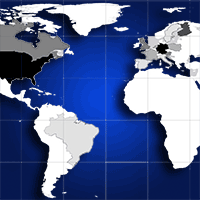
Biodiversity assessment in forests - from genetic diversity to landscape diversity
O Granke (1) , B Kenter (2), WU Kriebitzsch (1), M Köhl (1-2), R Köhler (2), K Olschofsky (2)
iForest - Biogeosciences and Forestry, Volume 2, Issue 1, Pages 1-3 (2009)
doi: https://doi.org/10.3832/ifor0474-002
Published: Jan 21, 2009 - Copyright © 2009 SISEF
Review Papers
Collection/Special Issue: Cost Action E29 Meeting 2008 - Istanbul (Turkey)
Future Monitoring and Research Needs for Forest Ecosystems
Guest Editors: Marcus Schaub (WSL, Birmensdorf, CH)
Abstract
Assessing biodiversity in forests requires a reliable and sustainable monitoring concept, which must include all levels of diversity, the genetic, the species and the landscape level. Diversity studies should not be reduced to quantitative analysis, but qualitative interpretations are an important part for the understanding of the results. Also, the linkage of terrestrial data and remote sensing data as well the implementation of abiotic and biotic data collected on existing monitoring systems are useful sources to analyse cause-effect relationships and interactions between the different aspects of diversity.
Keywords
Biodiversity, Monitoring, Remote sensing, Habitat modelling, Beech provenances
Authors’ Info
Authors’ address
WU Kriebitzsch
M Köhl
Johann Heinrich von Thünen Institute, Federal Research Institute for Rural Areas, Forestry and Fisheries, Institute for World Forestry, Leuschnerstr. 91 D-21031 Hamburg (Germany)
M Köhl
R Köhler
K Olschofsky
University of Hamburg, Department of Woodscience, Institute for World Forestry, Leuschnerstr. 91, D-21031 Hamburg (Germany)
Corresponding author
Paper Info
Citation
Granke O, Kenter B, Kriebitzsch WU, Köhl M, Köhler R, Olschofsky K (2009). Biodiversity assessment in forests - from genetic diversity to landscape diversity. iForest 2: 1-3. - doi: 10.3832/ifor0474-002
Academic Editor
Marcus Schaub
Paper history
Received: Mar 13, 2008
Accepted: Dec 09, 2008
First online: Jan 21, 2009
Publication Date: Jan 21, 2009
Publication Time: 1.43 months
Copyright Information
© SISEF - The Italian Society of Silviculture and Forest Ecology 2009
Open Access
This article is distributed under the terms of the Creative Commons Attribution-Non Commercial 4.0 International (https://creativecommons.org/licenses/by-nc/4.0/), which permits unrestricted use, distribution, and reproduction in any medium, provided you give appropriate credit to the original author(s) and the source, provide a link to the Creative Commons license, and indicate if changes were made.
Web Metrics
Breakdown by View Type
Article Usage
Total Article Views: 53728
(from publication date up to now)
Breakdown by View Type
HTML Page Views: 43459
Abstract Page Views: 4550
PDF Downloads: 4800
Citation/Reference Downloads: 59
XML Downloads: 860
Web Metrics
Days since publication: 6155
Overall contacts: 53728
Avg. contacts per week: 61.10
Citation Metrics
Article Citations
Article citations are based on data periodically collected from the Clarivate Web of Science web site
(last update: Mar 2025)
Total number of cites (since 2009): 5
Average cites per year: 0.29
Publication Metrics
by Dimensions ©
Articles citing this article
List of the papers citing this article based on CrossRef Cited-by.
References
Map of the natural vegetation of Europe. Federal Agency for Nature Conservation, Bonn, Germany.
Gscholar
Zeigerwerte von Pflanzen in Mitteleuropa. Scripta Geobotanica 18: 6-199.
Gscholar
Climate change 2007: the physical science basis. Summary for policymakers. Contribution of Working Group I to the Fourth Assessment Report of the Intergovernmental Panel on Climate Change. WMO, Geneva, Switzerland, pp. 21.
Gscholar
Applying objective data for a multi temporal analysis of habitat suitability indices to monitor biodiversity: a case study for the example key species Red kite (Milvus milvus) and Black stork (Ciconia nigra). Dissertation Universität Hamburg, Hamburg, Germany, pp. 221.
Online | Gscholar
Reference sample plots to combine field measurements and satellite data in forest inventories. Research Notes 19, Department of Forest Mensuration and Management, University of Helsinki, pp. 209-215.
Gscholar
Kritische Anmerkungen zum theoretischen Konzept der potentiellen natürlichen Vegetation mit Anregungen zu einer zeitgemäßen Modifikation. Tüxenia 7: 53-67.
Gscholar
Bedeutung trockener Sommer für Wachstumsfaktoren von verschiedenen Herkünften der Rotbuche (Fagus sylvatica L.). AFZ - Der Wald 62: 246-248.
Gscholar
Weiterentwicklung von Indikatoren zur Erfassung der Fragmentierung von Wäldern unter Berücksichtigung der Datenverfügbarkeit. Arbeitsbericht des Instituts für Weltforstwirtschaft der Bundesforschungsanstalt für Forst- und Holzwirtschaft und dem Zentrum für Holzwitschaft Universität Hamburg, 2006/2, pp. 43.
Gscholar
Definition of a system of nomenclature for mapping European forests and for compiling a pan European forest information system. FIRS Final Report.
Gscholar
Eignung von Diversitätsindizes bei Langzeituntersuchungn zur Biodiversität in Waldbeständen. Allgemeine Forst- und Jagdzeitung 167 (4): 76-85.
Gscholar
Land cover changes in Europe from the 1950’s to 2000. Institute for Wordforestry, University of Hamburg, Hamburg, Germany, pp. 364.
Gscholar
Biodiversity evaluation tools for european forests. Ecological Bulletins 50, pp. 237.
Gscholar
FRACSTATS. Spatial pattern analysis program for quantifying landscape structure - version 2.0. Corvallis, pp. 67.
Gscholar
Liste der in Deutschland typischen Waldgefäßpflanzen. Mitteilungen der Bundesforschungsanstalt für Forst- und Holzwirtschaft 212, pp. 66.
Gscholar
The mathematical theory of communication. University of Illinois Press, Urbana 1949.
Gscholar
Kombination von terrestrischen Aufnahmen und Fernerkundungsdaten mit Hilfe der kNN-Methode zur Klassifizierung und Kartierung von Wäldern. Dissertation. Technische Universität Dresden. Lehrstuhl für Forstliche Biometrie und Informatik.
Gscholar
Satellite image-based national forest inventory of Finland. International Archives of Photogrammetry and Remote Sensing 28 (7-1): 419-424.
Gscholar
Die heutige potentielle natürliche Vegetation als Gegenstand der Vegetationskartierung. Angewandte Pflanzensoziologie 13: 64-98.
Gscholar
Biodiversity: from Babel to biosphere management. Special features in biosystematics and biodiversity 2, Uppsala, Sweden, pp. 59.
Gscholar
Charakterisierung der Landschaftsstruktur mit Methoden der Satelliten-Fernerkundung und der Geoinformatik (Dissertation). TU Dresden, pp. 190.
Gscholar

















